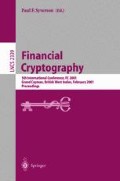Abstract
Consider a conditional access module, or CAM, which decrypts (or descrambles) content usingits knowledge of conditional access (CA) keys [6]. The CA-descrambled content is communicated to a set-top box (STB) to enable display. The alternative model in which the CAM or smart card acts as a permissioning device only, which transfers content-descrambling keys to the STB, may have lesser processing and data-rate requirements. However, successful attack under this latter model may not necessitate compromise of the CAM itself. The definition of successful attack varies depending on several factors. Localized forms of piracy may be harder to monitor, and thus control, but also should be of less concern to the providers of the legitimate infrastructure. In particular, unauthorized replay of rented content which does not result in additional revenue to the legitimate provider is qualitatively different than, say, taking delivery on two washing machines when only one was paid for. There is a fundamental distinction, however, between a consumer who pays the legitimate rental price once and reaps further play without further payment, and a large-scale pirate who compromises content and provides the ability for consumers to play content which does not result in payment to the legitimate provider proportional to the number of effective consumers of that content. In the case that there is a considerable difference between the rental price and outright purchase price of content, that is not to say that every consumer who is willing to pay the initial rental price and cheat the provider out of further revenue for any additional play would be willing to pay the full purchase price if cheating were not a reasonable alternative.
Access this chapter
Tax calculation will be finalised at checkout
Purchases are for personal use only
Preview
Unable to display preview. Download preview PDF.
References
B. Chor, A. Fiat, and M. Naor, “Tracing Traitors,” Advances in Cryptology: Proceedings of Crypto’94, Springer-Verlag, pp. 257–270, August 1994.
D. Goldschlag and D. Kravitz, “Pirate Card Rejection,” PreProceedings of Cardis 98-Third Smart Card Research and Advanced Application Conference, Louvain-la-Nueve, Belgium, September 14–16, 1998.
D. Goldschlag and D. Kravitz, “Beyond Cryptographic Conditional Access,” Proceedings of the USENIX Workshop on Smartcard Technology, Chicago, Illinois, pp. 87–91, USENIX Association, May 10–11, 1999.
P. Kocher, J. Jaffe, and B. Jun, “Differential Power Analysis,” Advances in Cryptology: Proceedings of Crypto’99, Springer-Verlag, August 1999.
O. Kommerling and M. Kuhn, “Design Principles for Tamper-Resistant Smartcard Processors,” Proceedings of the USENIX Workshop on Smartcard Technology, Chicago, Illinois, pp. 9–20, USENIX Association, May 10–11, 1999.
D. Kravitz and D. Goldschlag, “Conditional Access Concepts and Principles,” Proceedings of the Third International Conference on Financial Cryptography, Lecture Notes in Computer Science 648, pp. 158–172, Springer-Verlag, 1999.
D. Sims, “DirecTV Hacks Back,” The Industry Standard, The Standard.com, http://biz.yahoo.com/st/010129/21749.htmlJanuary 29, 2001.
Author information
Authors and Affiliations
Editor information
Editors and Affiliations
Rights and permissions
Copyright information
© 2002 Springer-Verlag Berlin Heidelberg
About this paper
Cite this paper
Kravitz, D.W. (2002). Aspects of Digital Rights Management and the Use of Hardware Security Devices. In: Syverson, P. (eds) Financial Cryptography. FC 2001. Lecture Notes in Computer Science, vol 2339. Springer, Berlin, Heidelberg. https://doi.org/10.1007/3-540-46088-8_5
Download citation
DOI: https://doi.org/10.1007/3-540-46088-8_5
Published:
Publisher Name: Springer, Berlin, Heidelberg
Print ISBN: 978-3-540-44079-6
Online ISBN: 978-3-540-46088-6
eBook Packages: Springer Book Archive

